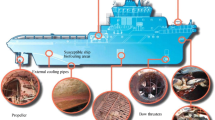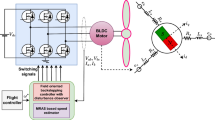Abstract
This paper discusses the path-following control of a ship or other floating object by pushing using a single autonomous tugboat. To do this, we first formulate a reduced dynamic equation that contains the dynamics of both the ship and the tugboat without contact force terms, and is expressed by independent variables, such as ship variables (surge, sway, and yaw rates), allowing us to deal with the ship and tugboat as a single system to control the independent variables. It is assumed in this study that the contact between the ship and tugboat is a point contact, and the contact point does not slip. To manipulate the motion of a ship by pushing, the pushing force must be exerted without slipping at the contact point. Thus, the contact force is derived from the dynamic equations of the ship and tugboat and the velocity constraints on the contact point, and its feasible region is defined. This contact force condition is then incorporated into a path-following control method using the reduced dynamic equation to handle the contact force during the pushing operation. The contact force is checked to determine whether it is likely to be exerted outside the feasible region; if so, the control gain used in the path-following control is switched to a smaller value. Simulations under different paths and contact positions are performed, and the results demonstrate that the proposed pushing control method allows the ship to follow a given path correctly while maintaining the contact condition.












Similar content being viewed by others
Change history
21 August 2023
A Correction to this paper has been published: https://doi.org/10.1007/s00773-023-00952-7
References
The Shipowners’ Club (2015) Tugs and tows - a practical safety and operations guide. The Shipowners’ Club, London
Feemster M, Esposito J, Nicholson J (2006) Manipulation of large objects by swarms of autonomous marine vehicles: part1 - rotation. In: Proceedings of the 38th southeastern symposium on system theory, p 255–259
Smith E, Feemster M, Esposito J (2006) Swarm manipulation of an unactuated surface vessel. In: Proceedings of the 39th southeastern symposium on system theory, p 16–20
Braganza D, Feemster M, Dawson D (2007) Positioning of large surface vessels using multiple tugboats. In: Proceedings of the American control conference, p 912–917
Esposito J, Feemster M, Smith E (2008) Cooperative manipulation on the water using a swarm of autonomous tugboats. In: Proceedings of IEEE international conference on robotics and automation, p 1501–1506
Bui V, Ji S, Choi K, Kim Y (2012) Nonlinear observer and sliding mode control design for dynamic positioning of a surface vessel. In: Proceedings of 12th international conference on control, automation and systems, p 1900–1904
Bidikli B, Tatlicioglu E, Zergeroglu E (2015) Robust control design for positioning of an unactuated surface vessel. In: Proceedings of IEEE/RSJ international conference on intelligent robots and systems, p 1071–1076
Mason MT (1986) Mechanics and planning of manipulator pushing operations. Int J Robot Res 5(3):53–71
Peshkin MA, Sanderson AC (1988) The motion of a pushed, sliding workpiece. IEEE J Robot Autom 4(6):569–598
Okawa Y, Yokoyama K (1992) Control of a mobile robot for the push-a-box operation. In: Proceedings of IEEE international conference on robotics and automation, p 761–766
Lynch KM, Mason MT (1996) Stable pushing: mechanics, controllability, and planning. Int J Robot Res 15(6):533–556
Kurisu M, Yoshikawa T (1997) Tracking control for an object in pushing operation. J Robot Syst 14(10):729–739
Ruggiero F, Lippiello V, Siciliano B (2018) Nonprehensile dynamic manipulation: a survey. IEEE Robot Autom Lett 3(3):1711–1718
Stüber J, Zito C, Stolkin R (2020) Let’s push things forward: a survey on robot pushing. Front Robot AI. https://doi.org/10.3389/frobt.2020.00008
Fossen T (1994) Guidance and control of ocean vehicles. Wiley, Chichester
Acknowledgements
This study was supported by a research promotion program through the Korea Maritime & Ocean University Research Fund in 2022.
Author information
Authors and Affiliations
Corresponding author
Additional information
Publisher’s Note
Springer Nature remains neutral with regard to jurisdictional claims in published maps and institutional affiliations.
The original online version of this article was revised: Corrections have been made in the paragraph before the equation 31.
About this article
Cite this article
Choi, JK. Path-following control of a ship by pushing using a single autonomous tugboat. J Mar Sci Technol 28, 649–657 (2023). https://doi.org/10.1007/s00773-023-00946-5
Received:
Accepted:
Published:
Issue Date:
DOI: https://doi.org/10.1007/s00773-023-00946-5




